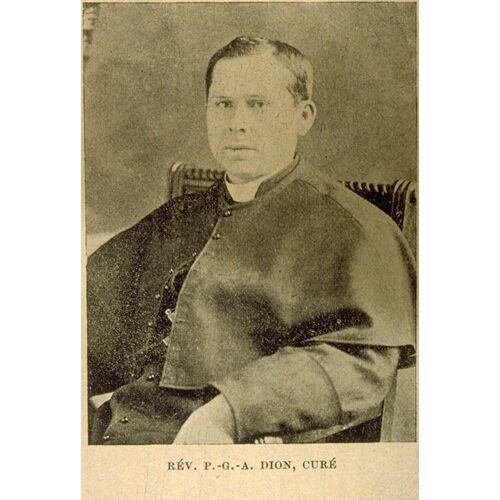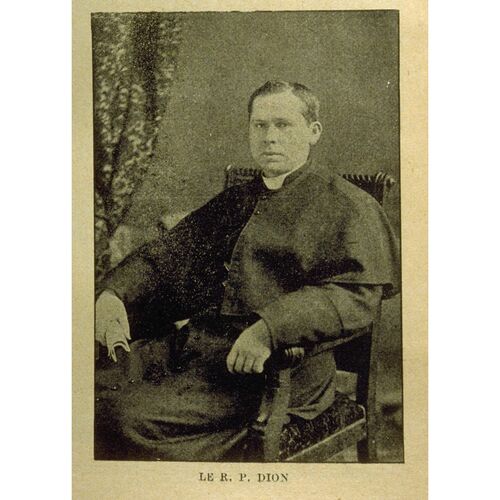DION, GEORGES-AUGUSTE, priest and member of the Congregation of Holy Cross, professor, and provincial superior; b. 19 Sept. 1852 in Saint-Pierre-de-la-Rivière-du-Sud, Lower Canada, son of Calixte Dion, a farmer, and Angèle Picard; d. 8 Oct. 1918 in Côte-des-Neiges (Montreal).
Georges-Auguste Dion was the youngest of 12 children. After finishing his studies at the school on their concession, he joined his four brothers on the family farm, while his father devoted himself to his work as a blacksmith. He began his classical studies at the Séminaire de Nicolet in September 1868, but transferred four years later to the Collège de Saint-Laurent near Montreal. Shortly after, he entered the noviciate of the Holy Cross Fathers, took the habit on 13 Feb. 1873, and made his vows on 19 March 1874. He was ordained priest on 24 Sept. 1876. His whole life would thereafter be dedicated to God and to his community.
Father Dion was appointed initially to the Collège de Saint-Laurent, as professor of philosophy the first year and prefect of discipline the second. In the summer of 1878 he was named superior of the Collège de Farnham, a small establishment that had just been transferred to the Congregation of Holy Cross. During his eight years as superior, he succeeded in tripling the size of the building that housed the college. After a year at the Côte-des-Neiges noviciate as master of novices, he returned to the Collège de Saint-Laurent as professor of French and prefect of French studies. From 1888 he retained the latter office and served as superior also.
At the general chapter meeting in 1892 Father Dion was elected procurator general to the Holy See. The beauty of Rome enchanted him, as daily entries in his journal show. With his appetite for activity, however, he found sporadic commissions to the Roman congregations a meagre diet. He tried to supplement it by engaging in a ministry to nuns and by contributing regularly to a religious magazine in France. Before his term of office expired, he received an urgent call to return to the province of Quebec. His journal entry for 2 Feb. 1896 notes: “I received this morning a letter from the Very Reverend Father General, ordering me, in the name of holy obedience, to return to Canada to replace the late [Philippe] Beaudet.” He made no further comment on the subject, although it was a matter that called for it. Father Beaudet, who had just died, was the provincial superior in Canada. Dion bade farewell to Rome on 18 February and went off to the parish of Saint-Laurent, where he would carry out the duties of both provincial superior and curé.
At that time the Congregation of Holy Cross, resident in Saint-Laurent since 1847 [see Joseph-Pierre Rézé*], had 194 members divided among 12 establishments including the Collège de Saint-Laurent, the College of St Joseph in Memramcook, N.B. [see Camille Lefebvre*], and academies and commercial colleges in the dioceses of Montreal and Saint-Hyacinthe. During his term as provincial, Father Dion founded four training houses for Holy Cross recruits and supplied brothers to teach in the parish schools of seven curés. In 1906 he decided to transfer the administration of the province to the Collège Notre-Dame in Côte-des-Neiges; he also assumed the principalship of this establishment, which since 1869 had taken pupils ranging in age from five to twelve years.
Dion’s main purpose in moving to Côte-des-Neiges, however, was to keep a close watch on the progress of St Joseph’s Oratory. In 1904 he had given Brother André [Alfred Bessette*] permission to build a tiny chapel dedicated to the patron saint of Canada. Since that time pilgrimages had been organized and were continuing to grow. In the face of this groundswell, firm judgement was essential. His daily dealings with Brother André soon led him to believe in his providential mission. He made known this conviction to Archbishop Paul Bruchési* of Montreal, who authorized him to give free rein to the development of the project. In 1911 a monastery was built near the now enlarged little chapel, and the following year he took up residence there with two priests and three brothers, including Brother André. The Annales de Saint-Joseph was founded in 1912, and he became its editor. In 1909 Dion had also set up the Confrérie de Saint-Joseph du Mont-Royal to encourage the veneration of St Joseph. He was relieved of his duties as provincial during the summer of 1912 but was obliged to resume them two years later, after his successor resigned for reasons of health. In the meantime plans had been initiated for a large church dedicated to St Joseph. In the fall of 1915 Dion was able to lay the foundations of the church and crypt, which would be opened on 16 Dec. 1917. All that day his heart burst with gratitude to God. As Archbishop Bruchési would recall at his funeral: “Father Dion . . . lived for his church; it was his chosen work.”
Dion’s health began to deteriorate, however, and in the summer of 1918, following a meeting of the provincial chapter, he suffered a cerebral embolism. Realizing he could no longer perform his duties, he resigned from his two positions, but his resignation was not accepted. Since he had held these positions until his strength was exhausted, he deserved to retain his title to them to the end. He was brought back to the community’s infirmary in Côte-des-Neiges in accordance with his desire to die among his own people, and he passed away there on 8 October. Since the churches were closed because of the influenza epidemic, a private funeral was held in St Joseph’s Oratory. It was conducted by Archbishop Bruchési, who in his eulogy described Father Dion as “one of the most distinguished and zealous members” of the clergy in the diocese.
Dion’s life was quite short, but full. Endowed with sound judgement and an active disposition, he brought honour to every office entrusted to him. He was also guided and motivated by an intense faith in Providence. His reason for choosing the priesthood and the religious life was above all to serve God better and to live in closer communion with Him. True to himself, therefore, he always made a point of dedicating a large part of his days to God. In Father Dion a passionate nature was imbued with a mystical spirit.
Father Georges-Auguste Dion is the author of two religious works: Manuel de la confrérie de Saint-Joseph du Mont-Royal (Montréal, 1909) and Recueil de prières indulgenciées à saint Joseph, modèle des chrétiens (Montréal, 1909). He also contributed several articles to the Annales de Saint-Joseph (Montréal) between 1912 and 1919.
A file on Father Dion is available at the Arch. des Pères de Sainte-Croix, Montréal (Q111), along with his correspondence (B1.10, 1D1, and 1H1.1), speeches and sermons (Q112), and journal, 1892–96 (Q113).
ANQ-Q, CE2-6, 19 sept. 1852. É.-J.[-A.] Auclair, “Le père Dion, provincial des religieux de Sainte-Croix,” La Semaine religieuse de Montréal, 4 nov. 1918: 297–303. Paul Bruchési, “Allocution . . . aux funérailles du R.P. Dion, c.s.c.,” Annales de Saint-Joseph, 7 (1918): 365–68. “Le rév. père Georges-Auguste Dion, c.s.c.,” Annales de Saint-Joseph, 7: 342–45. Sainte-Croix au Canada, 1847–1947 (Montréal, 1947).
Cite This Article
Roger Bessette, “DION, GEORGES-AUGUSTE,” in Dictionary of Canadian Biography, vol. 14, University of Toronto/Université Laval, 2003–, accessed January 1, 2026, https://www.biographi.ca/en/bio/dion_georges_auguste_14E.html.
The citation above shows the format for footnotes and endnotes according to the Chicago manual of style (16th edition). Information to be used in other citation formats:
| Permalink: | https://www.biographi.ca/en/bio/dion_georges_auguste_14E.html |
| Author of Article: | Roger Bessette |
| Title of Article: | DION, GEORGES-AUGUSTE |
| Publication Name: | Dictionary of Canadian Biography, vol. 14 |
| Publisher: | University of Toronto/Université Laval |
| Year of publication: | 1998 |
| Year of revision: | 1998 |
| Access Date: | January 1, 2026 |


![Saint-Laurent Rév. P.-G.-A. Dion, curé [image fixe] : Original title: Saint-Laurent Rév. P.-G.-A. Dion, curé [image fixe] :](/bioimages/w600.6674.jpg)


